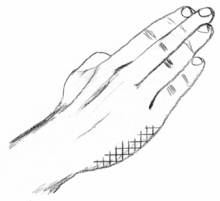Knifehand strike: Difference between revisions
Kevinvicario (talk | contribs) |
|||
| Line 42: | Line 42: | ||
==Military use== |
|||
==Military use== |
|||
Knifehands are widely used in the U.S Military, specifically the [[ United States Marine Corps ]],early in basic training recruits are taught that the knifehand is a Marine's best weapon. |
Knifehands are widely used in the U.S Military, specifically the [[ United States Marine Corps ]],early in basic training recruits are taught that the knifehand is a Marine's best weapon. |
||
True Marines will use them for the rest of their lives, and if they stay in long enough and pick up rank, they will employ them on lower rank Marines. The range of a knifehand attack varies from 2 to 500 feet, the closer the better. A Marine can also use the knifehand attack to correct another Marine if he is not squared away. |
True Marines will use them for the rest of their lives, and if they stay in long enough and pick up rank, they will employ them on lower rank Marines. The range of a knifehand attack varies from 2 to 500 feet, the closer the better. A Marine can also use the knifehand attack to correct another Marine if he is not squared away. |
||
Revision as of 02:33, 16 April 2012
This article needs additional citations for verification. (November 2007) |
This article focuses only on one specialized aspect of the subject. (October 2009) |
| Template:Wikify is deprecated. Please use a more specific cleanup template as listed in the documentation. |
| Knifehand strike | |||||||
|---|---|---|---|---|---|---|---|
 | |||||||
| Korean name | |||||||
| Hangul | None | ||||||
| |||||||
| Japanese name | |||||||
| Kanji | 手刀打ち | ||||||
| Hiragana | しゅとううち | ||||||
| |||||||
A knifehand strike is a strike using the part of the hand opposite the thumb (from the little finger to the wrist), familiar to many people as a karate chop (in Japanese, shutō-uchi). This refers to strikes performed with the side of the knuckle of the small finger. Suitable targets for the knifehand strike include the mastoid muscles of the neck, the jugular, the throat, the collar bones, the third vertebra (key stone of the spinal column), the upper arm, the wrist (knifehand block), the elbow (outside knifehand block), and the knee cap (leg throw).
In many Japanese, Korean and Chinese martial arts systems, the knifehand is used to block as well as to strike.
Japanese martial arts
Tegatana (手刀 : てがたな, Japanese for hand-sword) is a term from Japanese martial arts like aikido and Chinese-Okinawan martial arts like karate referring to a hand position that resembles that of the blade of a sword. This can be in a high, middle or low position but is usually extended outwards at about eye level (towards the carotid artery and nerve – a key strike point).
During practice, uke and tori will often stand opposite each other with their respective tegatana touching each other. From this position, considered by some the ideal combative distance for two unarmed opponents, many balance-breaking, striking and throwing techniques can be applied. In karate, the handsword collarbone chop (tegatana-sakotsu-uchi), the handsword collarbone strike (tegatana-sakotsu-uchikomi) and the handsword face chop (tegatana-ganmen-uchi) all use this fundamental strike as a basis for attack.
The knife hand strike can be used with both sides of the hand. Having the thumb tucked in, leaving the fore finger side of the hand free, allows that side of the hand to be used as a striking surface. This is called a inside knife hand where as the pinkie finger side is called outside knife hand.
Korean martial arts
In taekwondo a knifehand strike (sonkal taerigi) is executed by striking with the muscle at the side of the hand located between the base of the small finger and the wrist (abductor digiti minimumi). It is used as both an offensive and defensive technique and can be executed as a high, low, middle, side, inward, outward, rising or circular strike. Use of this technique as both a strike and block is featured prominently in many of the WTF Taegeuk poomse [1].
Fictional depictions
The popularity of martial arts in the mid to late 20th century gave rise to an exaggerated version of a knifehand strike widely used in American and British cinema, television, and animated cartoons. In common depictions, a character will deliver a single, precise-looking but relatively weak strike to the side of an opponent's neck, which instantly renders them unconscious but otherwise unharmed (in some versions, the blow is instantly fatal). This is frequently done from behind to an unaware adversary, often an enemy guard. The move became a staple of the spy genre through the 60s and 70s.
As audiences became more aware of how implausible this move seemed, it gradually migrated to the realm of comedy. In these depictions, it is either used unexpectedly and found to work in absurd situations, or a character attempts to imitate what they saw in film, only to find it has no effect.
Military use
Knifehands are widely used in the U.S Military, specifically the United States Marine Corps ,early in basic training recruits are taught that the knifehand is a Marine's best weapon. True Marines will use them for the rest of their lives, and if they stay in long enough and pick up rank, they will employ them on lower rank Marines. The range of a knifehand attack varies from 2 to 500 feet, the closer the better. A Marine can also use the knifehand attack to correct another Marine if he is not squared away.
"A Marine should know how to locate, close with, and destroy the enemy, with a knifehand attack"
Lt. GeneralLewis B. Puller
References
- Mas Oyama, Mas Oyama's Essential Karate, Fourth Publishing, 1980, Sterling Publishing Co., Inc.
